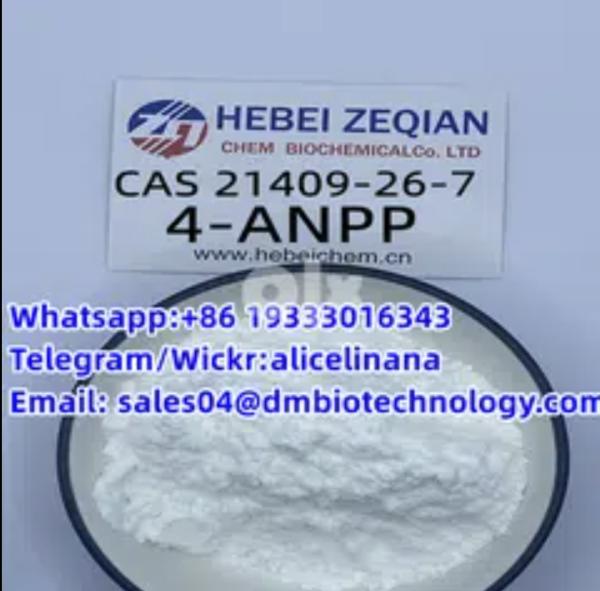There are precisely two things you can do with a bottle of 4-anilino-N-phenethylpiperidine, aka, 4-ANPP – a chemical that has been in the news recently.
- Use it to synthesize fentanyl (or a fentanyl analog).
- Give it to someone else so they can synthesize fentanyl (or a fentanyl analog).
Suffice it to say that someone in possession of 1 kilogram of 4-ANPP (provided that they're not a complete hack) who performs a very simple (1) reaction called an acylation will end up with about 1.3 kilograms of very pure fentanyl hydrochloride (2,3). (Quiz for non-chemists: How can you get more material than you start with? Can chemists really create matter? Any chemists who answer this will be flogged.)
Here's the reaction:

In the final step in synthesizing fentanyl. 4-ANPP, which, if caught with, will get you into the slammer but fast, is reacted with propionyl chloride, a common lab chemical (you can buy it from multiple chemical supply companies). Propionyl chloride is not a restricted chemical because it is used for various other purposes, although it is on New Jersey's Hazardous Substance List.
And well, it should be. Among its charming properties are the following:
- Highly toxic
- Highly corrosive. It causes serious burns to the skin and eyes upon contact.
- If you can avoid the full destruction of your sinuses, you'll be rewarded by the lovely scent of foot odor.
- Flammable
- It reacts violently with water, giving off hydrogen chloride gas, which can destroy your lungs.
- If you mix large amounts of propionyl chloride and water, it will blow up in your face, soon to be your former face.
So, while I said converting 4-ANPP to fentanyl is easy, this assumes minimal skills on the part of whoever is performing the reaction. But the same cannot be said for making the necessary 4-ANPP. You need real chemists with specialized skills to do this (more on this below).
The chemical has been in the news lately because of its obvious utility in synthesizing illicit fentanyl analogs (and certain analogs) but also as part of a bigger story: A rapidly-growing industry in Mexico based entirely on organic synthesis (3).
Making chemical intermediates (correctly) does require significant skill. Although none of the three reactions used to transform small, chemical building blocks into 4-ANNP is especially challenging, it nonetheless requires the sort of education of someone with a BA in chemistry. But there's another catch: Scale. Those of us trained to perform organic synthesis for drug discovery research typically work with amounts ranging from a few milligrams to 100 grams. But 100 grams of 4-ANPP isn't even close enough to supply someone planning on making 100 pounds of fentanyl (even if that person is pointing an Uzi at your head).
An analogy to drug discovery research
Let's say that a drug discovery chemist discovers Molecule X, which shows promise as a therapy for Disease Y. They will have made enough, maybe a few grams, to hand it over to biologists, toxicologists, and other groups that study pharmacological properties, such as stability and metabolism. A few grams is usually enough to conduct enough animal tests to look for red flags or some pre-clinical testing required to obtain an IND (4). But a few grams ain't squat when a drug is promising enough to enter the first stages of development; it usually requires more like a thousand times that, something that requires an additional skill set and a very different type of lab – one this is more likely to look like:

Photo credits: (Left) C&E News, PolyPeptide Group. (Right) PxHere. These kinds of labs are churning out huge quantities of fentanyl precursors.
So, what's the big deal about 4-ANPP? Convenience, and that's it. When the DEA seizes a package of 4-ANPP, it is guaranteed to be turned into fentanyl or a close analog. Here's an analogy: 4-ANPP is dough, and fentanyl is bread.
Bottom line
The availability of large quantities of 4-ANPP guarantees that we will be seeing more and more fentanyl headed to the US. The DEA has a huge problem on its hands, and I don't know how to solve it. Perhaps if the agency devoted more manpower to this and less to busting doctors who prescribe higher than "suggested” quantities of Percocet, it might help. Then again, it might not. Simple organic chemistry has created a complex (and very dangerous) problem.
NOTES:
(1) Simple, as in, could easily be performed in the kitchen at a Waffle House
(2) The internet drug site Erowid, a Wild-West of information on mind-altering drugs, provides a recipe for how to make fentanyl hydrochloride. The formation of the hydrochloride salt serves to purify the product from the last reaction in the synthetic sequence, making it > 99.5% pure.
(3) Amines are a general category of nitrogen-containing organic compounds that are basic enough to react with hydrogen chloride (the gas that makes hydrochloric acid). In doing so, they form hydrochloride salts. The root chemical is the same in the free base and the salt, but the physical properties are different. The salts are more soluble in water, (usually) more crystalline, and more chemically stable. Pharmaceutical fentanyl is typically the salt of citric acid, hence the name fentanyl citrate on the bottle.
(4) IND is short for investigational new drug application, which, if approved, permits the testing of a new drug in humans.




